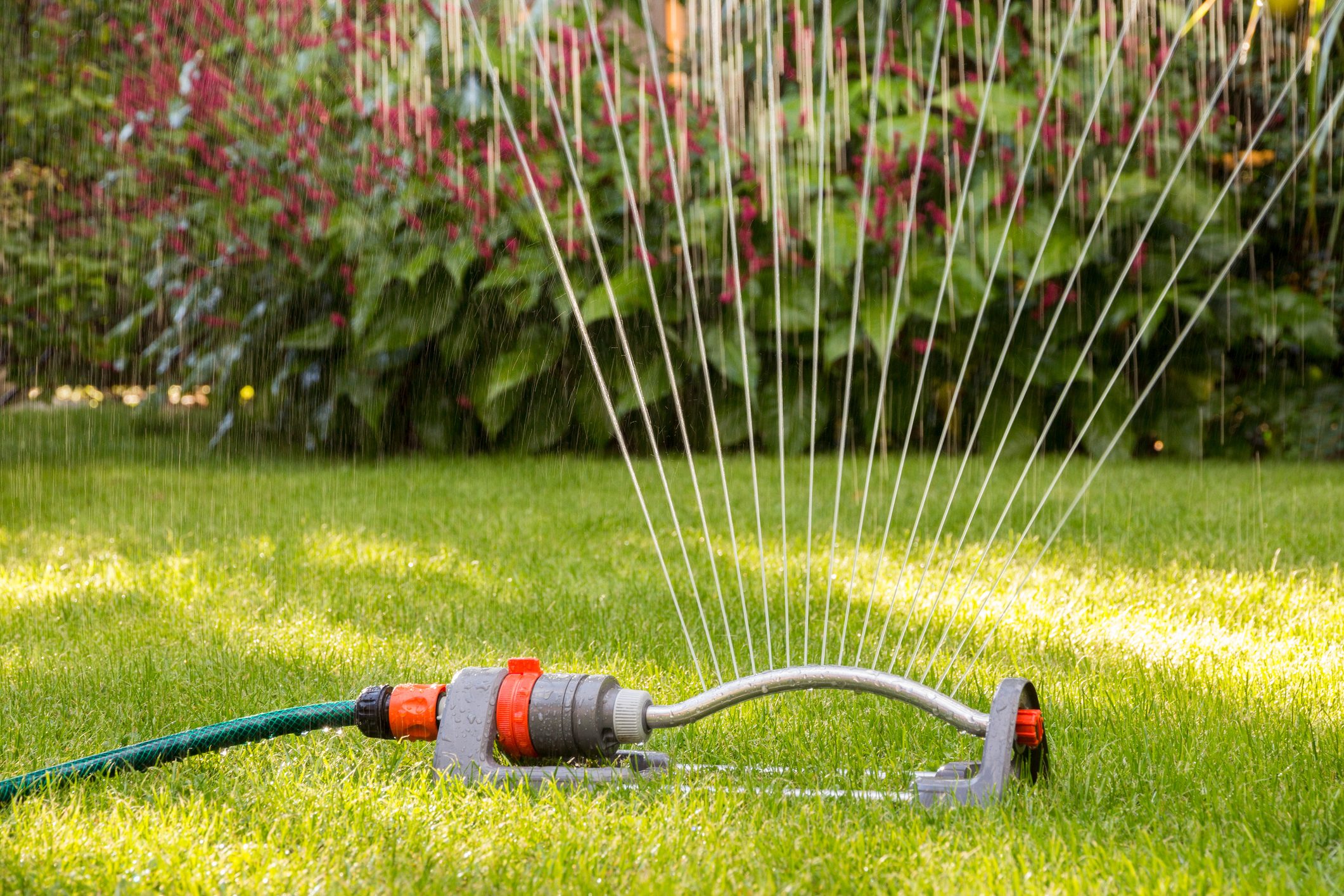When the experts advise how much to water your lawn, the amount might not be as much as expected.

Here’s How Much Water Your Grass Really Needs

Before I started learning about landscaping, I always thought the more the merrier was a good mantra when considering how much to water my lawn. However, overwatering can be as much of a problem as underwatering for turfgrasses, both leading to yellowing and other lawn health issues.
I spoke with two turfgrass experts to understand how much to water lawns to keep them looking lush and what factors influence watering frequency and volume.
On This Page
How Much Should I Water My Lawn?
“Most lawns require about 1 to 1.5 inches of water per week, either from rainfall or irrigation,” John Kaminski, Associate Professor of Turfgrass Management in the College of Agricultural Sciences at the Pennsylvania State University, explains. Also, it’s best to water deeply and slowly once or twice a week rather than a light daily watering, which won’t support the development of deep grass roots.
However, while this is a helpful guide, the optimal amount and frequency depend on various factors.
What Factors Influence How Much To Water My Lawn?
Grass species, soil composition and seasonal conditions all play a part in how much to water your lawn.
Lawn type
The species of turfgrass you select can influence how much you water your lawn at different times of the year. “Cool-season grasses (like Kentucky bluegrass or tall fescue) tend to need more water during hot, dry summers,” Kaminski says. “Whereas warm-season grasses (like bermudagrass or zoysiagrass) are more drought-tolerant, but still benefit from consistent moisture in peak summer.
Lawn age
A newly seeded lawn requires more frequent, shallower watering than an established lawn.
Season
Slow, deep watering once or twice a week is usually ideal during the summer months. “This approach encourages grass to develop a deeper root system, making it more resilient to heat and drought,” Kaminski says. He recommends allowing the water to penetrate at least 6 to 8 inches into the soil. “In spring and fall, when temperatures are cooler, you can usually cut back on watering unless it’s particularly dry,” he says.
Soil composition
Fast-draining sandy soils may need more water, more regularly than slow-draining clay soils, which hold moisture for longer.
Other environmental conditions
While you would expect to give more water in hot, dry regions, it’s not just temperatures that affect the rate of water required for your lawn.
“The most important [environmental] conditions are radiant energy (sunlight), atmospheric vapor pressure (relative humidity), temperature, wind movement, and available soil moisture,” Grady Miller, professor and extension turf grass specialist, explains. “Minimal water is used under dark, cloudy days with high relative humidity, low temperatures, and little to no wind.”
You need to provide the most water for your lawn during bright sunny spells with low relative humidity, high temperatures and moderate to high winds.
How Much Should I Water a Newly Seeded Lawn?

When watering new grass seeds, you need to do this frequently and shallowly. This ensures even moisture on the soil surface, allowing the seeds to germinate and establish roots. “[Watering] 2 to 3 times per day for the first couple weeks helps prevent the seedbed from drying out,” Kaminski says. “Once the seedlings emerge and begin developing roots, you can gradually reduce the frequency and increase the depth of watering to encourage deeper root growth.”
Signs You Are Underwatering Your Lawn
While yellow or brown patches on your lawn are well-known signs that it isn’t getting enough water, it’s good to look for earlier signs you are underwatering. That allows you to remedy things before you need to fix a patchy lawn.
Kaminski suggests looking for subtle signs of wilting and discoloration. “Grass blades that turn a dull bluish-green or begin to curl are often moisture-stressed,” he says.
He also recommends the “footprint test.” “If your footprints stay visible on the lawn for more than a few minutes, it’s a sign the grass isn’t springing back and may need water.”
What Are The Signs I Am Overwatering My Lawn?
Signs of an overwatered lawn can be similar to an underwatered one—in that it can also turn yellow and develop bare patches. However, it can also be more soggy-looking and weed or fungi-infested. Plus, a layer of thatch can develop more rapidly, as the excess water prevents the soil and grass from effectively breaking down the plant material buildup.
Kaminski says you might also see water run off onto paths and driveways, as your soggy lawn can’t absorb more moisture effectively.
Tips To Avoid Overwatering a Lawn
Overwatering is one of the most common lawn mistakes. Follow these tips to prevent this from causing shallow root growth, disease development and water wastage.
- Install a rain sensor or smart irrigation controller: Kaminski explains that these adjust water amounts to account for weather changes.
- Use a rain gauge: This allows you to measure how much water your lawn is receiving.
- Check your soil: “If it feels soggy or water is pooling, dial it back,” Kaminski says.
- Water early in the morning: Your lawn is active at this time and will absorb the water it needs. Any excess can evaporate off during the hotter part of the day.
About the Experts
- John Kaminski, PhD, is an Associate Professor of Turfgrass Management in the College of Agricultural Sciences at the Pennsylvania State University.
- Grady L. Miller, PhD, is a Professor and Extension Turfgrass Specialist in the Crop and Soil Sciences Department at North Carolina State University.



















